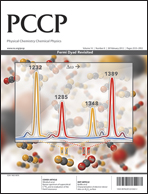We report the synthesis and characterization of dimeric viologen salts (1′,1′′-(alkane-1,n-diyl)bis(1-ethyl-4,4′-bipyridinium) with n = 4–10) with bis(trifluoromethanesulfonyl)amide (bistriflimide, Tf2N−) as a counteranion. For n = 4, 5 and 6, and for the nonylviologen cation (1,1′-dinonyl-4,4′-bipyridinium) we also prepared salts with the totally inorganic dodecatungstosilicate anion, SiW12O404−, featuring a poly-charged surface and nanosized dimensions. The materials have been characterized by means of calorimetric techniques, X-ray diffraction and solid state NMR and a comparison is made with analogous monomeric viologen salts exhibiting smectic mesophases. A strong odd–even effect is observed in the melting points and in the thermal behaviour of the bistriflimide dimeric systems, similar to what was reported for dipolar calamitic liquid crystal dimers, although the studied viologen dimers are not mesomorphic. By increasing the size of the counteranion we have observed a destabilization of the crystal phases and of the mesophases in favour of a glassy amorphous state. Implications on the design of novel ionic liquid crystals are discussed. The electrochemical behaviour in solution has been investigated by cyclic voltammetry measurements: interestingly, the odd–even effect is clearly visible also in the redox potentials. The spin-pairing of the viologen radical cations formed at each end of the dimer is responsible for the observed redox trend. Insights on the structure of the spin-paired dimer have been obtained by DFT calculations.

You have access to this article
 Please wait while we load your content...
Something went wrong. Try again?
Please wait while we load your content...
Something went wrong. Try again?


 Please wait while we load your content...
Please wait while we load your content...